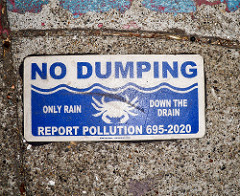
Contact: Karen Wood, CLF, (617) 850-1722, ; Jon Devine, NRDC, (202) 289-6868, ; Jeff Odefey, American Rivers, (914) 584-8972,
Press Release
07/10/2013
WASHINGTON, DC (July 10, 2013) — Conservation groups filed petitions today urging the Environmental Protection Agency (EPA) to exercise its authority to safeguard rivers, lakes, and streams from polluted runoff from existing commercial, industrial, and institutional sites that are currently failing to adequately control their pollution. Polluted runoff – rainwater that picks up oil, dirt and toxins while flowing over streets and parking lots – is a leading cause of water pollution in the United States.
Conservation Law Foundation (CLF), the Natural Resources Defense Council (NRDC) and American Rivers, along with Anacostia Riverkeeper, Anacostia Watershed Society, Blue Water Baltimore/Baltimore Harbor Waterkeeper, California Coastkeeper Alliance, PennFuture, Potomac Riverkeeper, and the Shenandoah Riverkeeper, jointly filed the petitions calling on EPA to exercise its authority under the Clean Water Act, known as Residual Designation Authority (RDA), on a regional scale spanning EPA Regions 1 (New England), 3 (Mid-Atlantic states) and 9 (Southwest states and California) to manage runoff from sources that are already contributing to violations of state water quality standards.
These regions, which are home to some of the nation’s most iconic and threatened water bodies, could provide replicable leadership for the rest of the country. The petitions seek to hold commercial, industrial and institutional facilities accountable for controlling runoff that carries toxic pollutants, including lead, zinc, copper, nitrogen and phosphorus, off of their roofs, parking lots, and sidewalks into nearby waterways when it rains or floods.
Much of untreated polluted runoff comes from these types of sites, such as acres of shopping mall parking lots, industrial rooftops, and other commercial surfaces that were built decades ago. However, many of these sites are not currently responsible for reducing their runoff pollution. Yet, because city storm sewer systems have pollution control and cleanup obligations, taxpayers often are responsible for paying for infrastructure improvements to manage runoff. CLF, NRDC and American Rivers are asking EPA to grant their petitions so that the costs of managing this pollution will be more equitably distributed and that these sources take responsibility for the pollution they generate.
The petitions filed today are consistent with similar recent initiatives. In 2009, after years of advocacy, New England-based Conservation Law Foundation secured two RDA permits for sources of polluted runoff, both of which require sites to be improved to reduce their share of stormwater pollution into five impaired brooks in Burlington, Vermont and urban Long Creek in Southern Maine.
“Polluters must be held accountable to do their part to restore healthy lakes, rivers, wetlands and estuaries in communities across the U.S.” said Christopher Kilian, VP and Director of CLF’s Clean Water and Healthy Forests Program. “The runoff problem, which affects water bodies small and large, in big cities and small towns from coast to coast, will only get worse with the more frequent and severe storms we are seeing due to climate change. A problem of this magnitude can’t be solved stream by stream. It requires regional solutions to stem this tide of pollution and achieve cleaner water for everyone.”
The current petitions, like the ones previously filed by CLF, demand that EPA issue a permit to sources of stormwater pollution requiring them to reduce their impact to currently polluted waterways. That can be done by using techniques like green infrastructure to reduce runoff. Green infrastructure refers to solutions like permeable pavement and green roofs, which allow polluted runoff to filter into the ground instead of rushing off into nearby streams. If granted, the petitions could serve as a model for cost-effective clean water safeguards throughout the country to restore our nation’s waters for swimming, fishing, and wildlife.
“Green infrastructure is a simple, common-sense solution to our water pollution woes. EPA knows there are chronic water pollution problems that green infrastructure can effectively tackle, but Americans need the agency to lead by insisting on pollution controls for sources that are fouling our waters,” said Jon Devine, senior attorney at the Natural Resources Defense Council. “Clean waterways are not only vital for public health, they support healthy economies that generate billions of dollars and support millions of jobs across the nation.”
“When polluted runoff flows off of these sites, we all pay the price in the form of basement backups, flooded streets, rivers that are unsafe for swimming, and beach closures,” said Jeff Odefey, Director of Stormwater Programs for American Rivers. “Taxpayers shouldn’t shoulder the entire bill for managing runoff while these sites continue to pollute our rivers, lakes, and streams. It’s time for existing sources of pollution to take responsibility for their impact. These petitions ask EPA to use its existing authority under the law to make sure everyone is part of the solution.”
Background
Polluted runoff is one of the leading causes of pollution in the United States. As water flows over pavement, it collects a toxic mix of metals, chlorides, petroleum residues, and automobile fluids. Large volumes of runoff exacerbate flooding, contribute to basement backups, and create sewage overflows. The costs of this pollution are far-reaching, including:
• For two beaches in California, illnesses associated with swimming in water contaminated by polluted runoff cost the public over $3 million every year.
• The Federal Emergency Management Agency (FEMA) estimates that polluted urban runoff contributes to 25 percent of economic losses from flooding, totaling nearly $1 billion every year.
• Wet basements due to frequent flooding or sewer backups can decrease property values by as much as 25 percent.
• From closed beaches to unsanitary drinking water and safety hazards, billions of dollars in health care are estimated to be spent every year on the approximately 7.1 million mild-to-moderate cases and the 560,000 moderate-to-severe cases of infectious waterborne disease in the U.S.
• When approximately 25 percent of land surface is impervious to water, rivers and streams lose most of their biological diversity.
Under the Clean Water Act, the EPA has the duty to manage polluted runoff from sites that contribute to violations of water quality standards or are significant contributors of pollutants to our waters. Polluted runoff is one of the only growing sources of water pollution across the country. The good news is that we have a much better understanding of how to reduce it – including capturing and treating runoff from already existing sites. These petitions ask the EPA to get existing sources of polluted runoff to do their fair share to reduce their impact.
###
American Rivers is the leading organization working to protect and restore the nation’s rivers and streams. Rivers connect us to each other, nature, and future generations. Since 1973, American Rivers has fought to preserve these connections, helping protect and restore more than 150,000 miles of rivers through advocacy efforts, on-the-ground projects, and the annual release of America’s Most Endangered Rivers®. Headquartered in Washington, DC, American Rivers has offices across the country and more than 100,000 supporters, members, and volunteers nationwide. Visit www.americanrivers.org, www.facebook.com/americanrivers and www.twitter.com/americanrivers.
Anacostia Riverkeeper is the voice for clean water and healthy communities in the Anacostia watershed. Like a “neighborhood watch” for the watershed, we patrol our streams and rivers and hold all accountable to their environmental responsibilities. We advocate for clean water laws that are fair and enforced consistently.
The Anacostia Watershed Society (AWS) is dedicated to cleaning the water, recovering the shoreline, and honoring the heritage of the Anacostia River and its watershed communities in Washington, DC, and Maryland. Since 1989, AWS has worked to conserve and protect the land and water of the Anacostia River and its watershed communities through educational programs, stewardship efforts, and advocacy projects. AWS works to make the Anacostia River and its tributaries swimmable and fishable as required by the Clean Water Act. For more information about AWS, visit www.anacostiaws.org.
Blue Water Baltimore’s mission is to restore the quality of Baltimore’s rivers, streams and Harbor to foster a healthy environment, a strong economy and thriving communities. Our singular focus is clean water. Blue Water Baltimore is the home for the Baltimore Harbor WATERKEEPER, who monitors water quality, organizes cleanups, advocates for government responsibility, and takes legal action.
California Coastkeeper Alliance unites 12 local Waterkeeper programs to fight for swimmable, fishable and drinkable waters for California communities and ecosystems. CCKA was founded in 1999 with the belief that a healthy ocean and coast and clean water is vital to California’s economy, public health and way of life. Visit us at www.cacoastkeeper.org and follow us on Twitter @CA_Waterkeepers.
Conservation Law Foundation (CLF) protects New England’s environment for the benefit of all people. Using the law, science and the market, CLF creates solutions that preserve natural resources, build healthy communities, and sustain a vibrant economy region-wide. Founded in 1966, CLF is a nonprofit, member-supported organization with offices in Maine, Massachusetts, New Hampshire, Rhode Island and Vermont.
The Natural Resources Defense Council (NRDC) is an international nonprofit environmental organization with more than 1.4 million members and online activists. Since 1970, our lawyers, scientists, and other environmental specialists have worked to protect the world’s natural resources, public health, and the environment. NRDC has offices in New York City, Washington, D.C., Los Angeles, San Francisco, Chicago, Livingston, Montana, and Beijing. Visit us at www.nrdc.org and follow us on Twitter @NRDC.
PennFuture creates a just future where nature, communities and the economy thrive. By conducting strategic campaigns for policy change and by enforcing laws, we are the guardian of the environment and public health as well as the most effective advocate for a clean economy.
Potomac Riverkeeper, Inc., a grassroots, nonprofit organization founded in 2000, includes the Potomac Riverkeeper and the Shenandoah Riverkeeper. Potomac Riverkeeper stops pollution and restores clean water in the Potomac and Shenandoah Rivers and their tributaries through community engagement and enforcement of the Clean Water Act and other environmental laws. Potomac Riverkeeper, Inc. has over 2700 members throughout the four states and the District Columbia that comprise the almost 15,000 square mile Potomac watershed. It has offices in DC, Maryland, Virginia and West Virginia.
www.potomacriverkeeper.org

Communications Consultant Lola Dvorak supports CCKA’s strategic communications by helping waterkeepers tell their stories.



